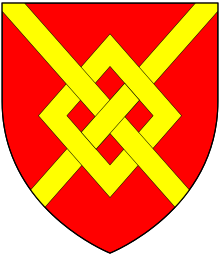Hugh de Audley, 1st Earl of Gloucester
Hugh de Audley | |
|---|---|
| 1st Earl of Gloucester | |
 Arms of Audley: Gules, a fret or | |
| Other titles | Lord of the Manor of Chilton[1] Lord of the Manor of Gratton |
| Born | c. 1291[2] Stratton Audley, Oxfordshire, England |
| Died | 10 November 1347[2] Kent, England |
| Buried | Tonbridge Priory, Kent, England |
| Noble family | de Audley |
| Spouse(s) | Margaret de Clare[2][3] |
| Issue | Margaret de Audley[2] |
| Father | Hugh de Audley, 1st Baron Audley of Stratton Audley[2][3] |
| Mother | Isolt Mortimer[2][3] |
Hugh de Audley, 1st Earl of Gloucester, 1st Baron Audley (c. 1291 – 10 November 1347) of Stratton Audley in Oxfordshire, and of Gratton in Staffordshire, served as Sheriff of Rutland and was the English Ambassador to France in 1341.[4] He was buried in Tonbridge Priory.[2][3][5]
Origins
[edit]Hugh was born at Stratton Audley, the second son of Hugh de Audley (c. 1267 – c. 1326) of Stratton Audley[4][2] by his wife Isolde (Iseult) le Rous (c. 1260 – 1338[4]), daughter of Sir Roger le Rous and Eleanor de Avenbury[2] and the widow of Sir Walter de Balun.[4][2] The 1st Earl had siblings including John de Audley (born c. 1293) and Alice de Audley (born c. 1304) who married firstly Ralph de Greystoke, 1st Baron Greystoke and later Ralph Neville, 2nd Baron Neville de Raby.[2]
Marriage
[edit]Hugh married Margaret de Clare,[6] widow of Piers Gaveston, 1st Earl of Cornwall, who was the favourite (and possibly lover) of King Edward II of England.[2][3] As Margaret was a sister of Gilbert de Clare, 8th Earl of Gloucester, who was killed at the Battle of Bannockburn in 1314, she brought the Gloucester estates to her husband.[7][8] By Margaret he had a daughter, Margaret de Audley (born c. 1318 in Stafford), who was abducted as his wife by Ralph Stafford, 1st Earl of Stafford.[9][2][3]
Career
[edit]Following his marriage, he was created Earl of Gloucester by King Edward III. He served as Sheriff of Rutland from 1316 to 1322 and again from 1327 to 1347.[5]
See also
[edit]External links
[edit]References
[edit]- ^ Page, W. (1927) Parishes: Chilton. A History of the County of Buckingham: Volume 4. Ed. London, England: Victoria County History.
- ^ a b c d e f g h i j k l m Hammond, P. W. (1998). The Complete Peerage or a History of the House of Lords and All its Members From the Earliest Times, Volume XIV: Addenda & Corrigenda.
- ^ a b c d e f Weis, F. L., Sheppard, W. L., & Beall, W. R. (1999). The Magna Charta Sureties, 1215: The Barons Named in the Magna Charta, 1215, and Some of Their Descendants who Settled in America During the Early Colonial Years. Genealogical Publishing Com.
- ^ a b c d J. R. Maddicott, 'Audley, Hugh, earl of Gloucester (c. 1291–1347)’, Oxford Dictionary of National Biography, Oxford University Press, 2004.
- ^ a b Fuller, T. (2013). The history of the worthies of England, Volume 3. Hardpress. ISBN 9781313240130.
- ^ Holmes 1955, p. 207.
- ^ Brown 1928, p. 588.
- ^ Chisholm, Hugh, ed. (1911). . Encyclopædia Britannica. Vol. 12 (11th ed.). Cambridge University Press. p. 128.
- ^ Ward 2013, p. 15.
- ^ Calendar of Inquisitions Post Mortem - Edward III
Sources
[edit]- Brown, Carleton (1928). "A Thirteenth-Century Manuscript from Llanthony Priory". Speculum. 3 (4 (Oct.)): 587–595.
- Holmes, G.A. (1955). "A Protest against the Despensers, 1326". Speculum. 30 (2 (Apr)): 207–212.
- Ward, Jennifer C. (2013). English Noblewomen in the Later Middle Ages. Routledge.
External links
[edit]- de Audley family genealogy
- de Audley family genealogy at OurFolkGen.com
- Heighley Castle, Madeley Staffordshire - home of the Audley family Madeley village website with history of Audley family
